“We need sustained rain over a number of weeks to recover” say Canal & River Trust experts, as drought causes challenges for boaters, marine businesses, holidaymakers and the UK’s largest canal charity.
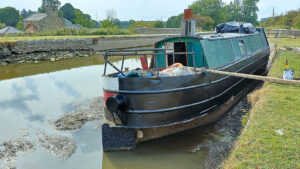
Boats have been left stranded, navigation restricted, and businesses “exceptionally quiet” during peak summer months across the inland waterways of England and Wales.
Northern canals have been the worst affected by the canal crisis, however, low water levels have also caused navigation restrictions in parts of the Midlands and the south, with pinch points hampering cruising routes.
The water shortfall situation in England has been defined as a “nationally significant incident”.
A “lack of rain” is the issue, rather than the recent heatwave, say Canal & River Trust (CRT) experts, with drought across many regions caused by the driest spring since 1893 and warmest UK summer on record – according to the Met Office – with six to nine months of below-average rainfall.
Engineering and maintenance work has also meant lowering or emptying water levels at some CRT reservoirs across the charity’s 2,000-mile network.
Dr Adam Comerford, CRT national hydrology manager, told The Water Road podcast the trust’s 72 reservoirs have an average age of 200 years old yet need to be maintained to meet modern-day safety standards, which “involves lowering, or emptying, the water levels so we can work safely on some of the assets.”
He said: “Stringent safety standards are the top priority, but it does mean that in some parts of the network, some of our reservoirs and our canals have been on the back foot, in terms of starting the boating season without absolutely everything full.”
A CRT navigation update said while the “majority of the network is open and navigable”, there was “particular pressure on reservoirs feeding the Ashton, Caldon, Grand Union Leicester Line, Grand Union Leeds & Liverpool, Macclesfield, Peak Forest, Rochdale, South Oxford and Trent & Mersey canals.”
CRT head of boating Matthew Symonds said: “Despite a few heavy downpours recently, we need sustained rain over a number of weeks to recover.
“We know how disappointing the current restrictions are, and we’re working with hire boat companies who are ensuring that holidays booked continue wherever possible by diverting boats onto routes that are available.
“As soon as water levels allow, we’ll get the canals back open.”
Boaters are advised to share locks and to sign up on the CRT website for automated alerts.
Boater stranded since May
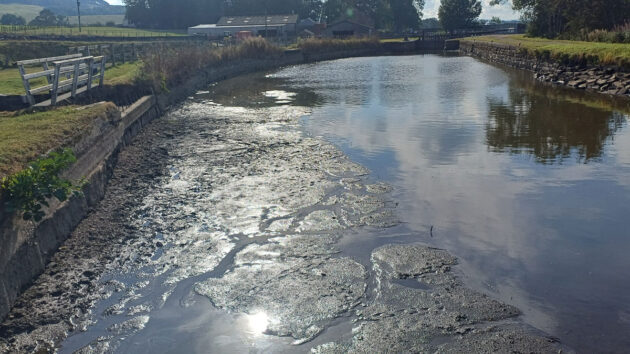
Low water level at Gargrave pound, North Yorkshire. Credit: Adam Mckinstry
Adam McKinstry’s 45ft narrowboat had been stuck at Gargrave pound since the locks closed on 22 May, and is likely to remain there until October.
He said: “It’s the first time in my 35-40 years of boating that my boat’s been literally sat on the bottom.
“It’s at a slant, but there doesn’t look to be any damage.
“The silver lining to the fact it’s on the ground means I have been able to do a bit of blacking to the bottom of the boat.”
Adam, who works for Skipton Boat Trips, said it was fortunate business was able to carry on as usual in that 17-mile pound.
Ruth Chamberlain, who runs a chandlery at Venetian Marina, said the impact of the canal crisis was that their takings were “roughly 55% down” for August, and “September appears to be worse than that so far.”
She told PBO: “Boats rarely go past us on the Middlewich branch now.
“We can only survive during this time as a shop because we run a fuel delivery service on the Shropshire Union Canal and Llangollen Canal all year around.
“This starts to pick up this time of year onwards as people begin to start lighting their fires, so they buy coal, logs and kindling.
“We are hoping that the Trent and Mersey can reopen without risk of breaching and we can get back to providing our land-based service which compliments our boat service.”

Low water levels at Gargrave, near Skipton. In some places wash walls have collapsed, adding to the canal crisis. Credit: Zoe Venn/Pennine Cruisers of Skipton
Zoe Venn’s family company Pennine Cruisers of Skipton made the difficult decision last year to sell off its holiday boat fleet to make the business more drought-resistant by focusing on day hire, skippered boat trips and boat maintenance work.
She said: “We knew that CRT had a lot of planned reservoir work in 2025 so even without a drought we would have seen some closures.
“Pennine Cruisers has always done holidays so it felt wrong to stop but in hindsight it was the right decision.
“Having to cancel holidays during a drought, regardless of planned closures, is seen as ‘an act of God’, which means you don’t get any insurance help with refunding customers, and CRT weren’t open to the idea of reducing boat licence fee charges for vessels that were unable to operate.”
She added: “Some private boaters are disappointed that CRT hasn’t used the opportunity to make repairs to the canals where drought conditions have led to areas naturally being exposed.
“In some places wash walls have collapsed and nothing has been done to recover the stone ready to rebuild.”
A CRT spokesperson responded: “Our bank-side colleagues and volunteers, supported by the hydrologists in Adam’s team, have been working tirelessly all year maintaining feeders, carrying out repairs, ashing-up gates and doing everything possible to keep boats afloat.
“That focus on managing all available water has taken the utmost priority and has bought additional time and resource pressures for them above and beyond a normal hydrological year.
“Where possible, works have been brought forward, for example, the repairs at Foxton, reported by the BBC.”
Finding solutions

When lock time restrictions were introduced, after an “initial panic”, Steve Furniss said his team at Grand Union Narrowboats, Northamptonshire, found a solution by moving boats, staff and kit to locks below Stoke Bruerne. Credit: www.grandunionnarrowboats.co.uk
When lock time restrictions were introduced between Weadon and Stoke Bruerne, Steve Furniss, director of Grand Union Narrowboats in Northamptonshire, said after an “initial panic”, he and his team “managed to find a solution; moving some of the boats, all the bedding, spares, tools and staff to down below the locks at Stoke Bruerne.”
Steve, who has worked in the industry for 30 years, added: “It’s worked out well. The biggest impact really is on myself as a small, family business.
“There’s been a lot of press about the water levels so there’s been a deluge of text messages, phone calls and emails from customers.
“It’s lucky that we’ve been able to say their holiday can still go ahead, albeit in a slightly different location.
“This is a very unusual event. The last big impact on this stretch of canal was in 1976.
“From my understanding, the previous time before was 1911.”
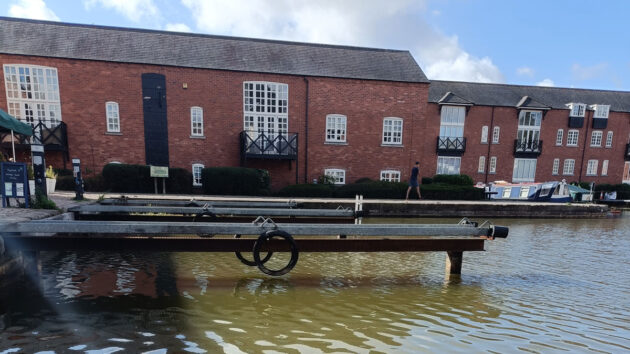
Low water level at the canal basin in Market Harborough. Credit: www.unionwharfharborough.co.uk
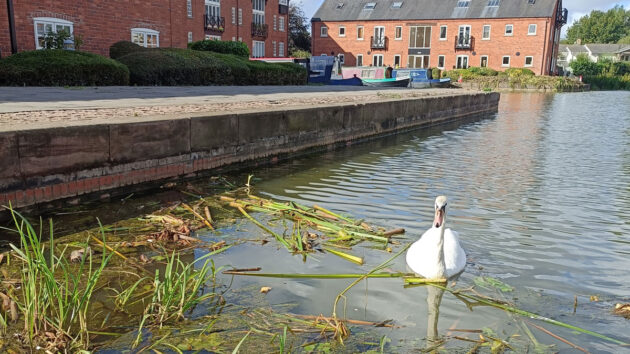
Sophie Jelley, at Boutique & Union Wharf Narrowboats, which runs a hire fleet and offers overnight moorings at Market Harborough, told PBO: “The canal restrictions have impacted us in two ways: we’ve had to relocate some hire boats to ensure guests still enjoy uninterrupted cruising, and we’ve seen fewer visiting boaters using our moorings and facilities, which is normally a reliable source of footfall and local support.
“It’s definitely been a quieter summer than we’re used to.”
Meanwhile, staff and volunteers at Carsington Sailing Club in Ashbourne, Derbyshire have been ‘working tirelessly’ to keep all RYA training going in the lake despite water levels being down around 50%.
Club spokesperson Megan Kelly said: “Cruisers and most of our moored boats came off the water mid-August. However we are keeping one keelboat in the middle of the lake over the winter so we can continue to teach RYA Level 1 and 2 Keelboat courses.
“We have put in lots of spare hours and huge efforts to keep our pontoons at the correct level with the water.
“Both staff and volunteers have been working together tirelessly to keep our club members on the water for as long as possible.
“Monthly newsletters have been updating club members about water levels and the work that is going on behind the scenes.”
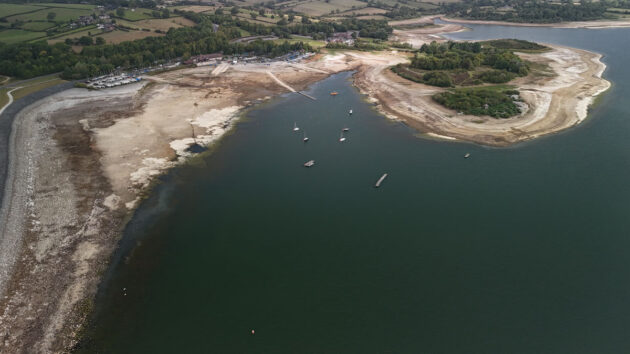
Aerial view of the drought impact at Carsington Water, Ashbourne, Derbyshire. Credit: www.carsingtonsailingclub.co.uk
Megan added: “Positives that have come out of this situation are that we have been able to teach students the importance of being able to launch and recover in trickier conditions; and how to do lee shore landings at a much earlier stage in their sailing career.
“Some of our regular club racers are being pushed out of their comfort zone and are using the wind shifts to their advantage – as the low water makes the wind a lot more inconsistent and shifts direction more regularly.
“Our wingers and windsurfers are trying out a new type of foiling, called Dock Starts, where they use an inflatable launcher and then run down the dock and jump on, a method to pump their way up to foiling.
“The damn wall provides a bigger sheltered area, for teaching beginners when the wind is strong.“
Canal crisis hurdle for new boat owner
New boat owner Christina Evans told PBO the 3.5 mile delivery of her new Sailaway Narrowboat from Collingwood Boat Builders of Liverpool turned into a three-and-a-half day odyssey due to water shortages and unexpected closures, and a breach that closed the Bridgewater Canal.
She ended up taking her 60ft, flat-bottomed shell on a daunting open-water route out onto the tidal River Mersey, then inland again via Eastham Lock, the Manchester Ship Canal, and Pomona Lock, to get ‘Fried Pussycat’ from Salthouse Dock, Liverpool to Oldfield Quay on the Bridgewater Canal.
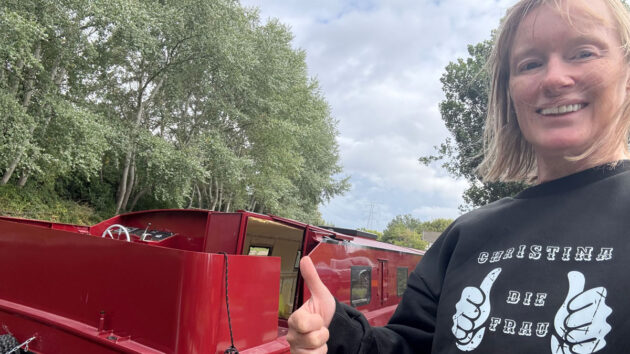
Relief for new boat owner Christina Evans after water shortages and canal closures turned a 3.5 mile delivery trip into a three-and-a-half day odyssey with a section across the tidal River Mersey. Credit: Christina Evans
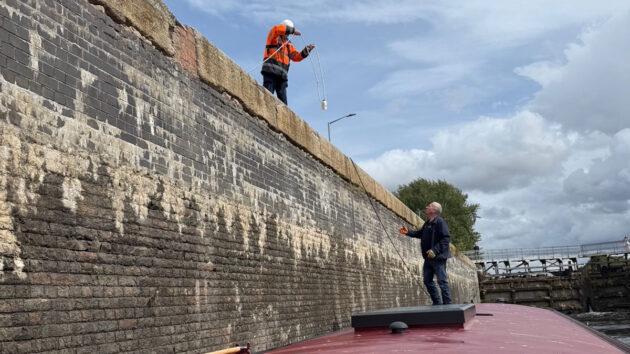
Christina said: “I suddenly had to plan a sea passage, get to grips with tidal navigation, and a mountain of permissions, licences, and marine safety rules – to cover 30 miles of obstacles to my home port.”
The Mersey “was merciless” as the empty shell of the new boat bucked on the waves, then Ellesmere Port Basin closed a day before arrival due to low water, and Fried Pussycat briefly grounded at Salford Quays, but Christina said the help of Mersey pilot Stuart Wood, family cheers and bacon butties at Oldfield Quay turned the ordeal into a triumph.
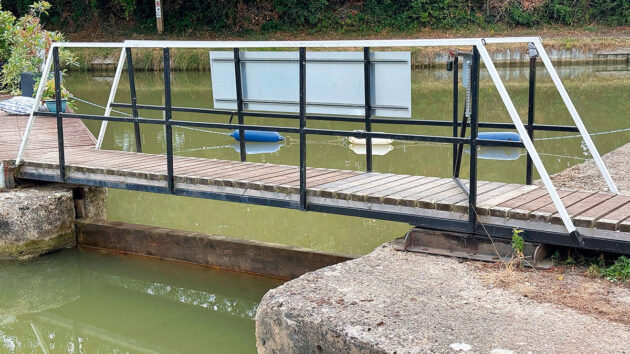
The stop planks in place at the Crick Wharf Marina Ltd to “preserve what water we have”. Credit: Emma Green
Emma Green, ABNB Boat Brokerage and Crick Wharf Marina owner, said Watford and Foxton lock closures on 29 July had “effectively cut off canal access to our brokerage at North Kilworth Marina”, causing sales to decline and impacting boat survey work, creating a backlog.
Crick winter moorers “have been unable to navigate to us,” she said, “resulting in the complete loss of our winter bookings, which form a vital part of our annual income.
“The lack of rainfall and continued closures across the network are creating a growing concern for the months ahead, both for our small family-run business and for the wider waterways community.”
Inland boating in the UK: a beginner’s guide
Rupert Holmes and Jonathan Mosse look at boats, seamanship skills, planning and destinations in their guide to inland boating in…
Mon and Brec Canal boating: Lessons learned from our first inland experience
For years my wife, Ann, and I have been Greek Mediterranean cruisers – we keep our Moody Eclipse Aderyn Glas…
Slow boat around Wales – coastal and inland circumnavigation in a Vivacity 20
When we first moved to Deganwy I saw a programme on Welsh television with a couple of guys from Aberaeron…
Want to read more articles like this?

A subscription to Practical Boat Owner magazine costs around 40% less than the cover price.
Print and digital editions are available through Magazines Direct – where you can also find the latest deals.
PBO is packed with information to help you get the most from boat ownership – whether sail or power.
-
-
-
- Take your DIY skills to the next level with trusted advice on boat maintenance and repairs
- Impartial, in-depth gear reviews
- Practical cruising tips for making the most of your time afloat
-
-
Follow us on Facebook, Instagram, TikTok and Twitter



Leave a Reply